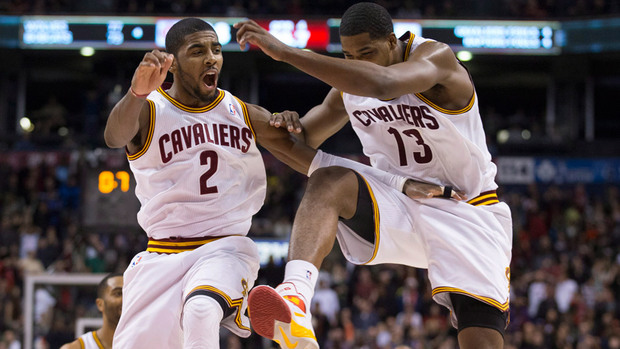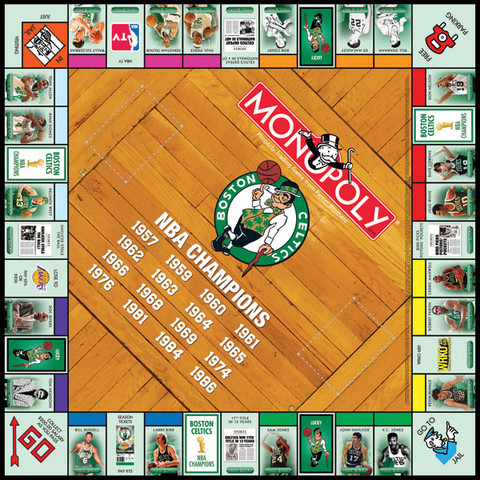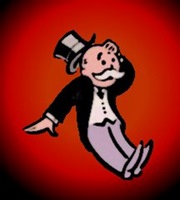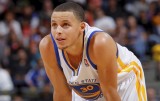I was following a number of Twitter discussions regarding Chris Paul’s apparent dissatisfaction with the Hornets and potential trade request, it prompted me to think about what system is best for the NBA.
Our esteemed ESPN TrueHoop colleague Matt Moore from Hardwood Paroxysm made these comments as part of a larger debate:
@HPBasketball: @needsrebooting so you have no problem with players being pawns, it’s taking control of the situation to creat superteams that’s lame
@HPBasketball: @ticktock6 so the owner can trade him whenever he wants, but the player made his decision and has to live with it?
These quotes certainly need to be viewed in context of the larger thread, but they provided inspiration for us to try to answer the questions:
How much freedom should the players have? And what impact could that have on compensation?
Give me six months and I’m sure I’d have enough to write a book on the topic. But we don’t have the time or space here. And this post is not a direct response to “Should Chris Paul have the right to ask for a trade?” – please don’t read it that way. It’s about maximizing the opportunity for both players and owners.
The league structure, as it exists today, has been quite effective. Why do I say that? The NBA salary cap gives us reasonable proxy as its derived from Basketball Related Income (BRI).
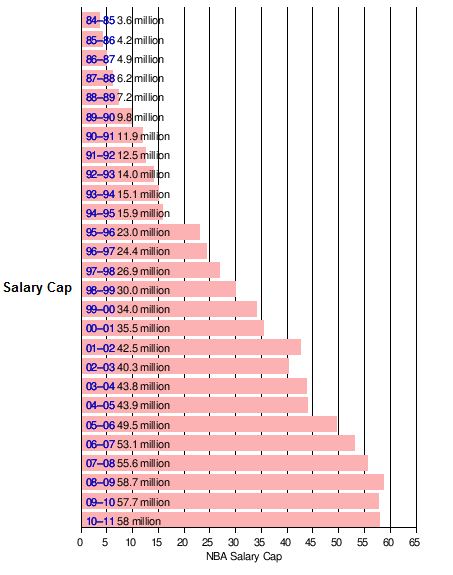
Source: Wikipedia
Over the last 25 years, this represents a CAGR of 11.7% – an incredible figure for that length of time. There are several explanations to explain this growth.
I will argue one key reason for the basis of this growth is: League parity
In part by its traditional definition
the “best” team is not significantly better than the “worst” team
But I would add that sport also needs
a structure also enables a poor team the opportunity to rebuild into a winner within reasonable time frame.
Certainly, in any one year, the best teams in the NBA are significantly better than the worst teams. However, there are not many easy wins over the course of a season. Most of the league is quite competitive – a quick highlight of this point is in the West last season, where the 2 through 8 seeds were separated by only 5 wins.
Why is this important? Why do you go to games? Why are TV ratings so high?
As Raptors fans, most of us keep going to games for a chance to see this and this. Or you’re constantly watching the game on TV to see these situations.
Revenue is driven by superstars – superstardom is a result of hitting big shots in close games. In close games. In close series. Going 7 games creates superstars. Close games are why fans show up. Close games drive revenue.
So what’s the point?
A completely free market basketball league will likely result in lower salaries.
Why? Let’s look at a completely free market system.
- No draft – you simply sign players – maybe you see potential at age 14 and you sign for their rights then.
- No salary cap.
- No restrictions on trade – no need to match salaries.
- etc.
What would happen in this scenario?
The vast majority of superstars would be signed early by the rich franchises. If they missed talent early, they’d simply pay up later.
So you would have teams like Boston, LA Lakers, Dallas (Cuban), New York, Chicago and perhaps a few other “haves”.
What would happen to other teams?
Below is a chart from NBA.com and Forbes magazine on the value of the top franchises.

We calculated that the top 10 teams averaged $24.1 million in operating income. The league average is only $7.8 million. Which means some teams are already losing a fair bit of money. In completely free market system, how would they have a chance in heck of signing marquee players? They couldn’t.
If you look at league attendance last season (here), you’ll find a solid correlation between filling the building and superstardom. What happens when you add a superstar? When the Celtics added Kevin Garnett and Ray Allen in the summer of 2007, home attendance went up 73,008 in 2008. With an average ticket price in the $65 range, that’s $4.7 million. Its also another 73,008 buying a couple of beer, hot dogs, hats, jerseys etc. The Celtics probably increased the luxury box fee as well. I More people are watching the local station for games. Thus, advertising revenue goes up. Can we round this to $10 million easily? I think so. The reverse is likely also true. Bloomberg pegged the loss of LeBron James could equate to the value of the Cleveland franchise declined $250 million. Yes, you read that correctly. The article also says:
The Cavaliers were coming off a 17-65 season when they took James, from Akron, Ohio, with the first pick in the 2003 NBA draft. Their average attendance that year was 11,497.
Over the course of 41 games, the Cavaliers sold 371,665 more tickets in 2009-10 than in 2002-03. Let’s call in $50 per seat – that’s an eye popping $18.6 million difference – without counting the spin-offs of luxury box price increases, more food and beverage sales, jerseys, etc.
Forbes claims that the Dallas Mavericks, Portland Trail Blazers, Orlando Magic, Atlanta Hawks, Sacramento Kings, Indiana Pacers, Charlotte Bobcats, New Jersey Nets, Minnesota Timberwolves, New Orleans Hornets, Memphis Grizzlies and Milwaukee Bucks are all losing money. In a free market scenario, could these teams take a further $5 to $20 million hit due to lower attendance? Not likely (well, besides Dallas).
What would this mean then?
It could mean that:
10 teams fold -> leading to significantly lower league attendance -> lower TV ratings -> lower merchandise sales -> lower basketball related income -> lower revenue for teams -> deepening losses.
And with perhaps 4 dominant teams, the remaining teams will struggle. Fans slowly stop showing up or watching – why bother if games are not competitive? Who wants to see 4 games sweeps through two rounds?
What happens in free markets? Industries often start with dozens of competitors, but only the strong survive over time. Ultimately you end up having a few strong players in a market segment. But that will not work in sport – it needs and thrives on many strong competitors.
Thus the need for the current system – tweaks can always be made. But its the draft structure, Bird rights, salary cap, revenue sharing that makes this league as successful as it is. Please don’t compare it to the “real world”. Yes, most of us have the opportunity to leave our employer for greener pastures if we don’t like the situation we’re in. A far-fetched example, but what about this offer – you have less flexibility in your choice of city, but because of this system we can pay you $5 million a year instead of $85,000. And you can live 4 months a year wherever you want. And after a few years, you can go wherever you want year round subject to a couple of conditions. Would you take it?
Here’s another simple way of looking at the situation: if the players are so constrained and would like a free market system, then just do it. All should quit the NBA, pool all their money and create a new league. One with complete freedom. They collectively have the money to do it. Go for it. Just don’t hire LRMR Marketing to run it. But without the checks and balances in order to keep some semblance of league parity, you’ll only have a few successful teams. And without group success, the rewards will be smaller. How many games will you enjoy when the final score is 132-96? Will you attend the next one between those two teams?
The NBA are experts in marketing. And to market this game to maximize revenue it requires some form of competitive balance. That’s why we pay big money to watch it. And its a system that greatly rewards the best players on this planet.

